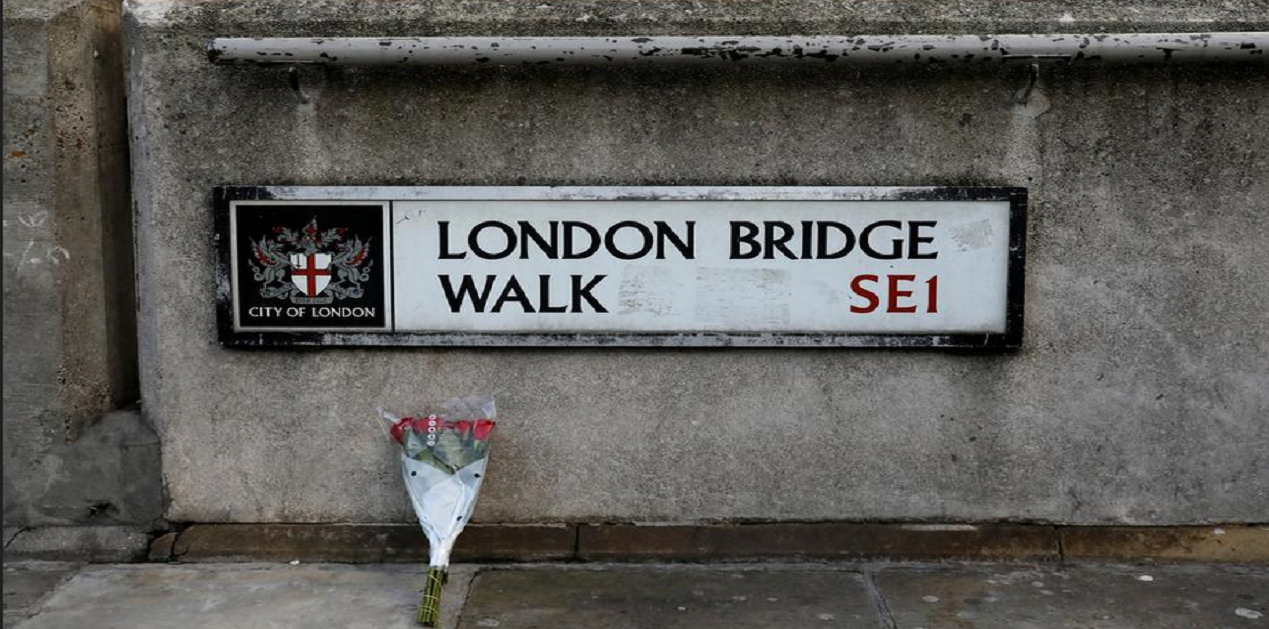“We are resolute, we stand United in the face of terrorism, and we will not allow anybody to divide us”. - Sadiq Khan, Mayor of London.
On 29 November 2019, a 28 years-old British terrorist identified as Usman Khan—a British citizen, carried out an attack using a kitchen knife and wearing a fake explosive vest, in central London. In this attack, two people were killed and other three were injured. At the time of attack, Usman Khan was on licence1 from jail where he was convicted for his previous terrorism offences in 2012.
The incident brought back memories of two similar attacks which had occurred in 2017 in London. In the afternoon of 22 March 2017, Khalid Masood—a 52 years-old British national carried out an Islamic State (IS)-inspired lone-wolf attack outside the Palace of Westminster in which five people were killed and 50 others injured. Khalid Masood had driven a vehicle, mowing down the people on the road and he later stabbed an on-duty Police officer with a knife before he was himself shot dead by the police on the grounds of the House of Commons. The Amaq news agency which is IS’s media outlet had claimed responsibility for the attack, but the British police had rejected the claim of IS and believed that Khalid Masood had acted alone.2
Another similar attack occurred after three months after the Westminster ‘lone-wolf’ attack. In the late-hours of evening of the 03 June 2017, a group of three IS operatives, similarly rammed a van into people at the London Bridge and later carried-out knife attack in the pubs and restaurants in the Borough Market area. Before getting shot down by the police officials, the attackers killed eight people, including four unarmed police officials who attempted to contain the assailants3. Like these two previous attacks of 2017, the latest one on 29 November 2019, was also an IS-inspired terror attack.
Following the recent killing of its supreme leader—Abu Bakr al-Baghdadi, it was expected that the operational capabilities of the Islamic State around the world would be significantly impacted, more so as it had already lost control of its territories, financial resources and manpower. However, it was also assessed that it still had the capability to launch a few ‘quick-fire’ low-risk attacks by local cells in selected European cities, including London. These were predicted as part of measures to assure the IS cadres worldwide that all was not lost.4 Therefore, despite the crackdown on IS channels and platforms on the social-media, including Telegram, the IS quickly claimed responsibility of the London attack, stating that it was carried out in response to IS calls to carry-out attacks on anti-IS forces or nations.5 There is a view that Usman Khan took advantage of the UK’s Automatic Prisoner Release Policy to carry out this attack. This aspect is discussed in the later part of this analysis.
The Perpetrator— Usman Khan
The perpetrator of this attack— Usman Khan had past history of terrorism offence charges under the UK law. In December 2010, he along with other eight people were arrested on the charge of conspiring to blow up the London Stock Exchange, and different pubs in Stoke, and further establishing a terrorist training camp in Pakistan.6 Along with Khan, in 2012, other two of his associates— Mohammad Shahjahan, and Nazam Hussein were also convicted for conspiring a terrorist attack.
Born in Stoke-on-Trent, Staffordshire, UK, to Pakistani immigrant parents, Usman Khan, in his nineteens and early twenties, was an active member of young Muslim activists who placed a stall every Monday in Waterloo road in Cobridge, distributing leaflets, turning away the youth of Muslim community from gang crimes, and held ‘public debates’ convincing people to convert to Islam.7 In 2008, on the basis of suspicion of Islamist extremism, the UK security services raided the house of Usman Khan’s sister where he used to stay, and seized computer, and other indiscriminating material. In March 2009, Usman Khan came under the influence of a British national-radical Islamist activist— Anjem Choudary, whom Khan invited as a guest speaker for a conference on Sharia Law at Cobridge Community Centre. After 20 months of investigation, the Crown Prosecution Service decided that there were insufficient evidence to prosecute Usman Khan and others for terrorism offences. 8 As mentioned earlier, Usman Khan was arrested in December 2010, and was sentenced for 16 years for terrorism offences in 2012.
As per the UK’s Automatic Prisoner Release Policy, Khan was released from jail in December 2018, with an ankle monitor. Ironically, despite the ankle monitor, Usman Khan managed to carry-out the attack. It is understood that as a recent released terrorist, Khan’s moves were monitored by the MI5 but not meant for constant surveillance.9 There were no indications that Khan would conspire such attack. In the case of IS’s Foreign Terrorist Fighter (FTF) returnees, it would be a challenge for British Intelligence community to determine the threat and to stop them using knife or vehicle-borne attacks.
Usman Khan’s Pakistan Connection
Apart from the fact that Usman Khan was born on British soil and his parents were Pakistani immigrant to the UK, Usman had spent some portion of his teenage years in Pakistan. After his return to UK, Khan got involved in preaching of radical Islam and had pledged to establish a terrorist training facility at a mosque on his family-owned land in Pakistan-occupied Kashmir (PoK).10 In an Independent Reviewer’s report on Terrorism Legislation 2013, submitted to the British Parliament, it was mentioned that Usman Khan, along with his other two associates— Nazam Hussain, and Mohammad Shahjahan, travelled to FATA (Federally Administered Tribal Area) in Pakistan and planned to establish, raising funds, and getting trained in a terror camp in Pakistan-Occupied Kashmir (PoK), with intentions to carry-out attacks in future.11
The Plot
The incident took place in the afternoon hours of 29 November 2019 at the Fishmonger’s Hall—a building adjacent to the London Bridge in the city of London. At the Fishmonger’s Hall, Usman Khan was attending an Offender Rehabilitation Conference and after few moments, he threatened to blow-up the Hall by detonating his suicide vest, which turned out to be a fake. Soon, he started attacking people with two knives which he had taped to his wrists and killed two participants— Jack Merritt (25 years) who was a coordinator of the rehabilitation programme and, Saskia Jones (23 years) who volunteered for the services at the event.12 With intentions to do more damage, Usman fled from the location, and began stabbing pedestrians on the north side of the Bridge. However, the general public displayed implausible courage and spraying fire extinguisher to disarm him, confronted Khan from doing further attacks.13 Soon, the Armed Police officials of City of London arrived at the scene, surrounded the attacker, shot twice aiming at Usman Khan, and killed him at the scene. 14
Automatic Prisoner Release Policy
In UK’s legislative context, Section 244 of the Criminal Justice Act 2003 places a duty upon the Secretary of State to release fixed-term offenders who were serving determinate sentences on licence or parole once they have served the required custodial period. This is known as an Automatic Release. 15 The sentences of Imprisonment for Public Protections (IIPs) or intermediate sentences were inducted in 2005 as a punishment to the sexual offenders or violent offenders who posed risk to the society. As per the intermediate sentence, a prisoner would stay behind the bars until considered to be safe to join the society. In other words, there was no parole or licence if the prisoner was thought to be dangerous. In December 2012, the rule was abolished but not for the existing prisoners.16
After his arrest in December 2010, Khan received an IPP (Imprisonment for Public Protection) sentence in 2012, with a minimum imprisonment of eight years, and the other two were given determinate or fixed-term sentences which is relatively a short-term plan to the possession of terrorist magazines. “These three [terrorists] were the ‘more serious threat’, and they should not be released until they were no longer a threat to the public”, said the then-London’s Woolwich Crown Court’s Judge, Justice Wilkie while announcing the sentence to Usman Khan and his two associates.17 Ideally, all the three terrorists (Usman Khan, Nazam Hussain, and Mohammad Shahjahan) should have been kept in prison for public safety. However, in 2013, all three appealed against the IPP or intermediate sentences, and received determinate extended sentences. In his judgement, Lord Justice Leveson of the Court of Appeal had stated that the decision by the Crown Court had ‘wrongly characterised’ all three terrorists as more dangerous than the rest of six who were arrested with them.18 Reportedly, Usman Khan was released on licence after he had two-third (2/3) of his sentence under previous legislation of 2003, which means Khan had to be physically imprisoned for eight years (the original sentence was of 16 years), as he was imprisoned for 408 days before his trial.19 Usman Khan was released in December 2018, with no involvement of the Parole Board over the review of his release. He and other two convicted terrorists likely to be of ‘no risk’ to the public.
What Lies Ahead?
A week after the London Bridge attack, the body of Usman Khan, who was shot by the police, was flown to Pakistan on 05 December 2019, for burial at his native place in PoK. The Muslim Community of Stoke-on-Trent had earlier objected to the funeral ceremony of Usman Khan being carried out in that town. According to one of the relatives (identity not disclosed) of Usman Khan, the funeral of Khan was attended by ‘large number’ of people of the village of Kajlani in PoK.20
Mohammed Chowdhury (29 years), an associate of Usman Khan who was convicted with Khan in 2012 over a conspiracy to bomb the London Stock Exchange, had breached his licence conditions twice and he is now set for release on licence at a Parole Board hearing scheduled for early next year, i.e. 2020.21
On other side, since 2000s, Anjem Choudary and his followers remained actively involved in recruiting the radicalise Muslims and in converting people to Islam by distributing leaflets, talks and protests across the UK. In 2016, for inviting support for the terrorist organisation Islamic State (IS), Anjem Choudary was arrested and jailed for five-and-half years. However, like in the case of Usman Khan, Anjem Choudary was freed from prison on 19 October 2018 on licence. Despite of his release, Anjem was considered as “genuinely dangerous”.22
With the UK General Elections scheduled for 12 December 2019, in view of this incident, the fate of the Automatic Prisoner Release Policy would depend on the new government. For the UK security services, it would be a challenge to keep UK safe and in preventing further terrorist attacks, small or big scale, at the time when radical extremists like Anjem Chaudary, Mohammed Choudhury, and may be other extremists, are freed on licence, and the threat of IS’s British terrorist returnees pose a serious National Security threat to the UK.
References:
- Licence or Parole is the early release of the prisoner who agrees to abide by certain conditions.
- Kim Sengupta. “Last message left by Westminster attacker Khalid Masood uncovered by security agencies”, Independent, 27 April 2017, Available from: https://www.independent.co.uk/news/uk/crime/last-message-left-by-westminster-attacker-khalid-masood-uncovered-by-security-agencies-a7706561.html
- Lizzie Dearden and May Bulman. “London terror attack: ISIS claims responsibility amid group’s ‘call for increased attacks’”, Independent, 04 June 2017, Available from: https://www.independent.co.uk/news/uk/home-news/london-terror-attack-isis-claims-responsibility-borough-market-bridge-a7772776.html
- Anurag Sharma, “Finally, Islamic State’s ‘Caliph’ is ‘Dead’!- An Initial Assessment”, Vivekananda International Foundation, 13 November 2019, available from: https://www.vifindia.org/article/2019/november/13/finally-islamic-state-s-caliph-is-dead-an-initial-assessment
- Antonio Villas-Boas. “The Islamic State claimed responsibility fo r the London Bridge knife terror attack”, Business Insider, 01 December 2019. Available from: https://www.businessinsider.in/international/news/the-islamic-state-claimed-responsibility-for-the-london-bridge-knife-terror-attack/articleshow/72313916.cms
- “Stoke terror sentences revised”, BBC News, 16 April 2013, Available from: https://www.bbc.com/news/uk-22168422
- Kathie McInnes. “We’re going to carry on until the last breath- How London Bridge murderer Usman Khan’s radicalisation began in Stoke-on-Trent”, StokeonTrentLive, 06 December 2019, Available from: https://www.stokesentinel.co.uk/news/stoke-on-trent-news/were-going-carry-until-last-3609481
- Ibid.
- Kim Sengupta. “Usman Khan: London Bridge attacker was ‘being monitored by MI5, but not under constant watch”, Independent, 30 November 2019, Available from: https://www.independent.co.uk/news/uk/home-news/usman-khan-london-bridge-attack-terrorist-mi5-surveillance-stabbing-a9227776.html
- “London Bridge attacker named as Usman Khan: Police”, Newsweek, 30 November 2019, Available from: https://www.newsweekpakistan.com/london-bridge-attacker-named-as-usman-khan-police/
- UK The Stationary Office, Report of the Independent Reviewer on the Operation of the Terrorism Act 2000 and Part 1 of the Terrorism Act 2006”, David Anderson Q.C., London: The Stationary Office, 2013, Available from: https://assets.publishing.service.gov.uk/government/uploads/system/uploads/attachment_data/file/243472/9780108512629.pdf
- “London Bridge attack: ‘Amazing heroes’ praised”, BBC News, 01 December 2019, Available from: https://www.bbc.com/news/uk-england-london-50608315
- “London Bridge: video shows public confront London Bridge attacker”, BBC News, 01 December 2019, Available from: https://www.bbc.com/news/av/uk-50615950/london-bridge-video-shows-public-confront-london-bridge-attacker
- “London Bridge knife attacker known to police and had links to terror groups”, Sky News, 02 December 2019, Available from: https://news.sky.com/story/london-bridge-police-dealing-with-incident-amid-reports-of-gunshots-11873515
- UK Draft Statutory Instruments, Explanatory Memorandum to the release of Prisoners (Alteration of Relevant proportion of Sentence) Order 2019, Available from: https://libguides.wvu.edu/c.php?g=418946&p=2855160
- Press Association. “Why was London Bridge attacker Usman Khan released?”, Evening Express, 30 November 2019, Available from: https://www.eveningexpress.co.uk/news/uk/why-was-london-bridge-attacker-usman-khan-released/
- “Nine jailed over bomb plot and terror camp plan”, BBC News, 09 February 2012, Available from: https://www.bbc.com/news/uk-16968518
- Press Association. “Why was London Bridge attacker Usman Khan released?”, Evening Express, 30 November 2019, Available from: https://www.eveningexpress.co.uk/news/uk/why-was-london-bridge-attacker-usman-khan-released/
- Steve Bird. “Leveson ruling opened the door to killer’s early release”, The Telegraph, 30 November 2019, Available from: https://www.telegraph.co.uk/news/2019/11/30/leveson-ruling-opened-door-killers-early-release/
- Charles Hymas and Ben Farmer. “London Bridge terrorist Usman Khan is buried in family village in Pakistan after UK backlash”, The Telegraph UK, 06 December 2019, Available from: https://www.telegraph.co.uk/news/2019/12/06/london-bridge-terrorist-usman-khan-buried-family-village-pakistan/
- Richard Ford, Fariha Karim, and Neil Johnston. “Mohammed Chowdhury, accomplice of London Bridge attacker, breached licence conditions”, The Times, 04 December 2019, Available from: https://www.thetimes.co.uk/article/mohammed-chowdhury-accomplice-of-london-bridge-attacker-also-breached-bail-hts07fkb2
- Sofia Petkar. “Free radical: who is Anjem Choudary and when was he released? Radical preacher jailed for terrorism offences at HMP Farkland”, The Sun, 11 November 2018, Available from: https://www.thesun.co.uk/news/3734162/anjem-choudary-radical-preacher-release-parole/
(The paper is the author’s individual scholastic articulation. The author certifies that the article/paper is original in content, unpublished and it has not been submitted for publication/web upload elsewhere, and that the facts and figures quoted are duly referenced, as needed, and are believed to be correct). (The paper does not necessarily represent the organisational stance... More >>
Image Source: https://s3.reutersmedia.net/resources/r/?m=02&d=20191201&t=2&i=1458941439&r=LYNXMPEFAT0FK&w=940











Post new comment